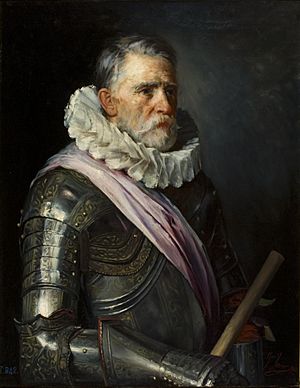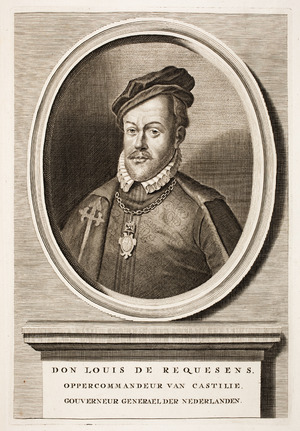Luis de Requesens y Zúñiga facts for kids
Luis de Requesens y Zúñiga (born August 25, 1528 – died March 5, 1576) was an important Spanish leader. He was a general, a sailor, a diplomat (someone who represents their country), and a politician. He served as the governor of the Duchy of Milan from 1572 to 1573. Later, he became the governor of the Spanish Netherlands from 1573 to 1576.
Contents
His Life and Career
Luis de Requesens y Zúñiga was born in Molins de Rei, which was part of the Spanish Empire at the time. His father, Juan de Zúñiga, was a teacher for King Philip II of Spain. Luis also had a brother, Juan de Zúñiga y Requesens, who later became the leader of Naples. Luis married Gerónima Esterlich y Gralla. Her father was a top finance official in Catalonia.
Early Roles
Luis started his career as a government official and a diplomat. In 1563, King Philip II trusted him to be his representative in Rome. This showed how much the king valued him.
In 1568, Luis became a high-ranking officer under John of Austria. They worked together to stop the Morisco Revolt in the Alpujarras region. He also joined John of Austria during the famous Battle of Lepanto. His job was to keep an eye on John, as the king worried about John's quick temper.
Becoming a Governor
In 1572, King Philip II made Luis the governor of the Duchy of Milan. This was a very important job, usually given to a noble. Luis was not a noble by birth, but the king favored him. He was known for being fair in Milan. However, he had disagreements with the archbishop, Charles Borromeo, who stood up for the local people.
In 1573, King Philip II called Luis to take over from Fernando Álvarez de Toledo, 3rd Duke of Alba. Luis became the new governor of the Spanish Netherlands. This area was rebelling against Spanish rule.
Challenges in the Netherlands
Luis was more moderate than the previous governor. He asked King Philip to forgive most of the rebels. He also suggested letting people who didn't agree with the rules leave the country.
The king wanted a more peaceful approach. But he did not want to give up any of Spain's demands. The Spanish treasury was also empty, which made things harder. Luis arrived in Brussels on November 17, 1573. He immediately started a new military plan.
In February 1574, the rebels captured the port of Middelburg, Zeeland. However, Luis's army won a victory against the troops of Louis of Nassau at the Battle of Mookerheyde. Sadly, two of William the Silent's brothers died in this battle.
Peace Talks and Setbacks
After the victory, Luis ran out of money to pay his soldiers. He had to try and make a deal with William the Silent, who was the leader of the Dutch rebels. The Emperor Maximilian II helped them talk. The discussions took place in Breda.
Luis said he would remove his troops from Flanders. But in return, only Catholicism would be allowed as a religion. By this time, Protestantism was very strong in the Netherlands. So, the Dutch refused his offer.
Luis started his military campaign again. His troops took over much of Zeeland. But then King Philip II stopped paying the Flemish troops. This caused the soldiers to rebel, and military actions stopped for a year.
Luis de Requesens died suddenly in Brussels in 1576. After his death, the Netherlands became very chaotic. John of Austria, King Philip II's half-brother, took over as governor. Luis's body was brought back to Barcelona and buried in his family's palace.
See also
- Eighty Years' War
- In Spanish: Luis de Requesens para niños



